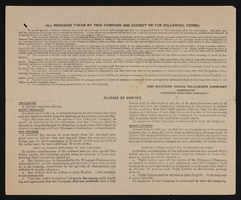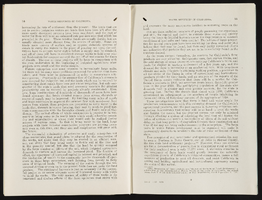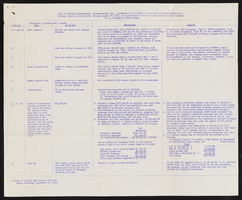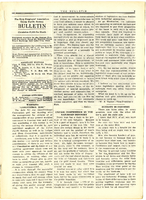Search the Special Collections and Archives Portal
Search Results
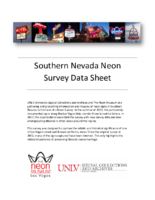
Fishers Inn Motel Neon Survey document, September 16, 2017
Date
2017-09-17
Archival Collection
Description
Information about the Fishers Inn Motel sign that sits at 3565 Boulder Hwy.
Site address: 3565 Boulder Hwy
Sign owner: Maiya LLC
Sign details: The construction of the motel was in 1963. This location was previously the Comet Motel but the Fisher's bought it in 1987 and changed the name to Fisher's Inn Motel.
Sign condition: 5 - received new paint in 2017
Sign form: Raised roadside sign
Sign-specific description: This sign has a thin white steel beam base with plastic backlit sign that currently advertises ESPN, HBO, Over 150 channels and Free Wifi. Above the reader board is a rectangular (but has a curved portion to the top of it) blue sign that states "FI" on top in a cursive font, underneath in a block white font states "A Fisher's Inn". Underneath "A Fisher's Inn" there is are big yellow "MOTEL" block font letters with a simple "No Vacancy" skeletal neon beneath it. At night the "FI" illuminates yellow, "A Fisher's Inn" green, " MOTEL" red, "NO VACANCY" is blue, but on the top portion of the sign there is white skeletal neon in the shape of possibly a Fisherman's hat.
Sign - type of display: Neon and backlit plastic sign
Sign - media: Steel and plastic
Sign - non-neon treatments: Backlit plastic sign
Sign environment: This motel is on Boulder Highway, close to the 515 and is near other motels and car sales lots.
Sign - date of installation: c. 1987
Sign - date of redesign/move: 2017 painted blue when it used to be green
Sign - artistic significance: There's a good use of multiple colors on this sign. As well as repurposing older signs from previous property has been a major trend for signs in Vegas. Good example of skeletal neon.
Survey - research locations: Assessor's website
Survey - research notes: Bookings website gives hotel info https://www.booking.com/hotel/us/a-fishers- inn-motel.html
Surveyor: Emily Fellmer
Survey - date completed: 2017-09-16
Sign keywords: Neon; Backlit; Plastic; Steel; Roadside
Site address: 3565 Boulder Hwy
Sign owner: Maiya LLC
Sign details: The construction of the motel was in 1963. This location was previously the Comet Motel but the Fisher's bought it in 1987 and changed the name to Fisher's Inn Motel.
Sign condition: 5 - received new paint in 2017
Sign form: Raised roadside sign
Sign-specific description: This sign has a thin white steel beam base with plastic backlit sign that currently advertises ESPN, HBO, Over 150 channels and Free Wifi. Above the reader board is a rectangular (but has a curved portion to the top of it) blue sign that states "FI" on top in a cursive font, underneath in a block white font states "A Fisher's Inn". Underneath "A Fisher's Inn" there is are big yellow "MOTEL" block font letters with a simple "No Vacancy" skeletal neon beneath it. At night the "FI" illuminates yellow, "A Fisher's Inn" green, " MOTEL" red, "NO VACANCY" is blue, but on the top portion of the sign there is white skeletal neon in the shape of possibly a Fisherman's hat.
Sign - type of display: Neon and backlit plastic sign
Sign - media: Steel and plastic
Sign - non-neon treatments: Backlit plastic sign
Sign environment: This motel is on Boulder Highway, close to the 515 and is near other motels and car sales lots.
Sign - date of installation: c. 1987
Sign - date of redesign/move: 2017 painted blue when it used to be green
Sign - artistic significance: There's a good use of multiple colors on this sign. As well as repurposing older signs from previous property has been a major trend for signs in Vegas. Good example of skeletal neon.
Survey - research locations: Assessor's website
Survey - research notes: Bookings website gives hotel info https://www.booking.com/hotel/us/a-fishers- inn-motel.html
Surveyor: Emily Fellmer
Survey - date completed: 2017-09-16
Sign keywords: Neon; Backlit; Plastic; Steel; Roadside
Text
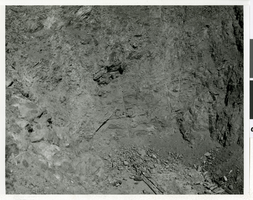
Photograph of the "Mole" Jarva Tunnel Borer at work on the Las Vegas River Mountain Project, Las Vegas, Nevada, circa 1968-1971
Date
1968 to 1971
Archival Collection
Description
The "Mole" Jarva Tunnel Borer pokes its nose out of the tunnel through mountain as work on the Las Vegas River Mountains Project progresses. The first stage of construction was completed between 1968-1971, and is comprised of a main aqueduct, a 3.78 mile tunnel through the River Mountains, eight pumping plants, and 31.4 miles of pipeline. This stage has a peaking capacity of 26.7 million cubic feet of potable water per day. The second stage enlarged the first stage system by expanding some of the existing facilities. New features included five pumping plants, the second barrel to the main aqueduct, and about 30 miles of pipeline and laterals with surge tanks, regulating tanks, and other delivery facilities. In conjunction with this stage, the State of Nevada enlarged and modified the Alfred Merritt Smith water treatment facilities to accommodate additional water supplies. The River Mountains Tunnel was constructed to full capacity in the first stage, and the Saddle Island intake facilities were oversized to accommodate both stages. The aqueduct system has a peaking capability of 53.4 million cubic feet of water per day. The River Mountains Tunnel was constructed during the first stage to accommodate second stage expansion. It is 3.78 miles long and was excavated through the River Mountains, which lie between Las Vegas Valley and Lake Mead. The concrete-lined tunnel has an inside diameter of 121.5 inches, and a maximum capacity of 608 cfs. The SNWA also constructed a larger tunnel, parallel to the River Mountains Tunnel for further expansion. The River Mountains Tunnel is used to convey raw water from Lake Mead to the River Mountains Water Treatment Facility that SNWA constructed near Henderson, NV. The River Mountains Facility, which began delivering treated water in October 2002, treats up to 300 million gallons of water per day, and was designed so it can expand to meet Southern Nevada's needs. In the future, the River Mountains facility will be able to treat up to 600 million gallons of water a day. This facility provides additional reliability and capacity to Southern Nevada's municipal water treatment and distribution capabilities.
Image
Audio recording clip of interview with Faye Todd by Claytee D. White, October 15, 1996
Date
1996-10-15
Archival Collection
Description
Part of an interview with Faye Todd by Claytee White on October 15, 1996. Todd discusses how she came to work for the Landmark and what it was like to work with entertainers.
Sound
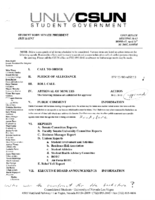
Meeting minutes for Consolidated Student Senate, University of Nevada, Las Vegas, April 21, 2008
Date
2008-04-21
Archival Collection
Description
Includes meeting agenda. CSUN Session 37 Meeting Minutes and Agendas .
Text

Sylvia Alvarado interview, April 12, 2019: transcript
Date
2019-04-12
Archival Collection
Description
Interviewed by Rodrigo Vazquez, Monserrath Hernández, and Barbara Tabach. Sylvia Alvarado talks about growing up in North Las Vegas and her Catholic upbringing in a Mexican household. Her studies in Journalism & Media Studies led her to her career as a radio host on English and Spanish-speaking programs. She also talks about speaking "pocha" Spanish and the Latinx influence in radio programming.
Text
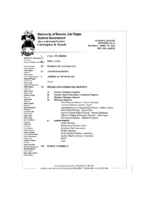
Meeting minutes for Consolidated Student Senate, University of Nevada, Las Vegas, April 28, 2003
Date
2003-04-28
Archival Collection
Description
Includes meeting minutes and agenda, along with additional information about bylaws, advertisements, and letters.
Text
Pagination
Refine my results
Content Type
Creator or Contributor
Subject
Archival Collection
Digital Project
Resource Type
Year
Material Type
Place
Language
Records Classification

